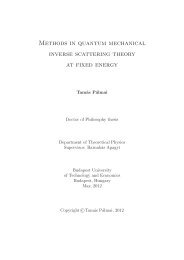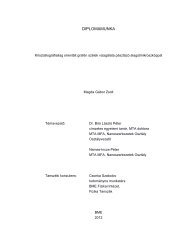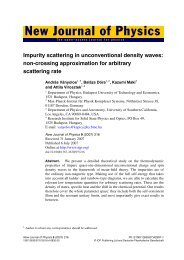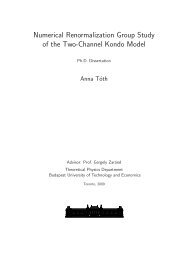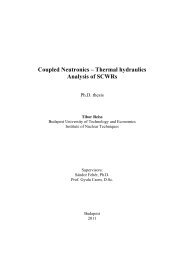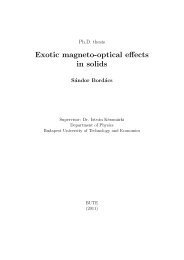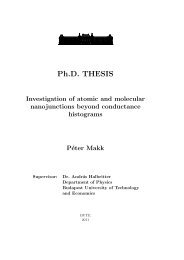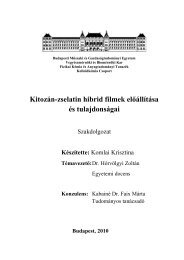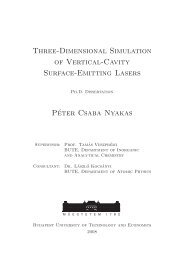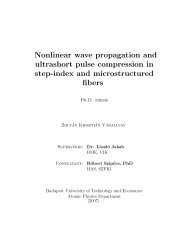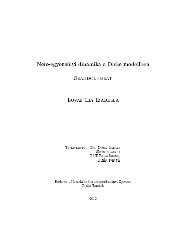Ph.D. THESIS Multipolar ordering in f-electron systems
Ph.D. THESIS Multipolar ordering in f-electron systems
Ph.D. THESIS Multipolar ordering in f-electron systems
Create successful ePaper yourself
Turn your PDF publications into a flip-book with our unique Google optimized e-Paper software.
Chapter 3 Octupolar Order<strong>in</strong>g of Γ 8 Ions 47<br />
+ 2 exp (Bjq/t) cosh (y H H/t)] . (3.22)<br />
Here g H and y H are the two parameters of the Zeeman splitt<strong>in</strong>g scheme of<br />
the Γ 8 subspace (see Appendix B). The overall shape of the phase boundary<br />
<strong>in</strong> the t–H plane can be obta<strong>in</strong>ed by expand<strong>in</strong>g free energy F(T , q, H) <strong>in</strong><br />
powers of T , and identify<strong>in</strong>g the coefficient of the T 2 -term<br />
α(H, t) = 1 2 −<br />
A2<br />
2g H H · s<strong>in</strong>h (g H H/t)<br />
cosh (g H H/t) + cosh (y H H/t) . (3.23)<br />
Solv<strong>in</strong>g α(H, t) = 0 gives a l<strong>in</strong>e of cont<strong>in</strong>uous transitions <strong>in</strong> the t–H plane<br />
(right part of Fig. 3.5).<br />
The free energy expansion with respect to the order parameters and the<br />
magnetic field is<br />
F(T , q, H) ≈ F(T , q, H = 0)<br />
+ g2 H − yH<br />
2 BjqH 2 − g2 H<br />
4t 2<br />
12t 4 H2 A 2 BjqT 2<br />
+ g2 H + 3y 2 H<br />
48t 3 A 2 T 2 H 2 . (3.24)<br />
The first term <strong>in</strong> the second l<strong>in</strong>e describes field-<strong>in</strong>duced Γ 5 quadrupoles.<br />
The absence of T H term from the free energy expansion gives that sharp<br />
octupolar phase transition is possible even <strong>in</strong> magnetic field. Note that this<br />
is a property of the model and H‖(111). In general, time reversal <strong>in</strong>variance<br />
would allow the existence of T H term.<br />
Follow<strong>in</strong>g the same calculation as we did <strong>in</strong> the H = 0 case, for the<br />
secondary order parameter we get<br />
B<br />
q ≈ −<br />
4t(t − B 2 j) · (<br />
A 2 T 2 + (gH 2 − yH)H 2 2) . (3.25)<br />
Replac<strong>in</strong>g this <strong>in</strong>to the free energy (3.24) and m<strong>in</strong>imiz<strong>in</strong>g it with respect to<br />
T , we get the primary order parameter <strong>in</strong> the field<br />
T<br />
≈<br />
=<br />
√ 8t(B2 j − t)<br />
( ) A · √<br />
2<br />
B 2 A 4 j 2 − t<br />
√<br />
8t(B2 j − t)<br />
·<br />
B 2 A 4 j<br />
+ A2<br />
24<br />
(A 2 − 8B 2 j)gH 2 + 3A 2 yH<br />
2 H<br />
t 2 (B 2 j − t)<br />
2<br />
√<br />
(t oc (H = 0) − t) − a H H 2 . (3.26)<br />
The second term of the product is the reduced temperature <strong>in</strong> magnetic field.<br />
Replac<strong>in</strong>g t = t oc (H = 0) = A 2 /2 <strong>in</strong>to the expression of parameter a H , it



